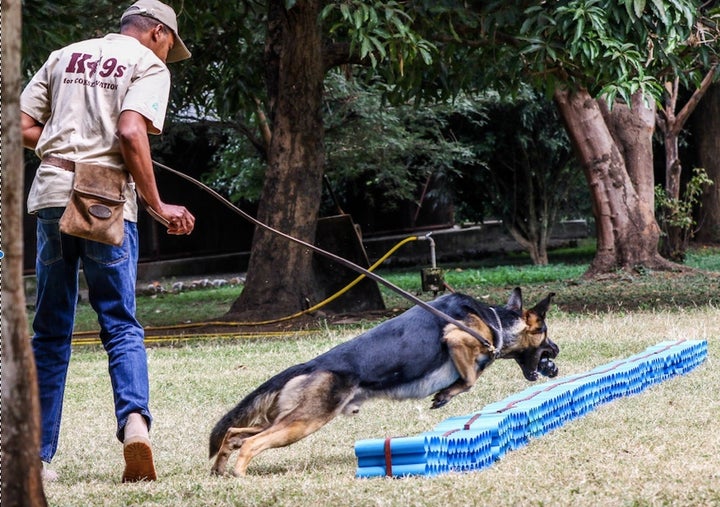
Canine handlers from Uganda, Tanzania, and Kenya demonstrate how sniffer dogs locate wildlife contraband during a learning exchange at AWF headquarters, Nairobi. Handlers are also trained to use the ‘Guidelines For Admissibility of Detection Dog Evidence.’
Going to the dogs – a K-9 program
“I just got a message yesterday – somebody who had been arrested at Nairobi international airport. This guy has been transporting ivory sticks, beads, rings, bangles.” - Dr. Phillip Muruthi, Chief Scientist, African Wildlife Foundation (AWF) (Series part 1)
In the conservation work of Dr. Phillip Muruthi, habitat science mingles daily with criminal law. Take this ivory interception at Nairobi Airport that Muruthi mentioned in our interview. It came across his inbox because AWF’s innovative Canine Conservation Program made it possible. Years in the making, this program came together when Kenya-based Muruthi and his organization AWF hooked up with Will Powell, a Tanzania-based dog trainer. The collaboration made sense. In spite of AWF efforts – educating local communities in conservation and training rangers for employment around wildlife reserves and corridors – contraband continued to slip through export hubs like the Nairobi airport. Meanwhile, Powell was training dogs in Tanzania after years spent training bomb detection dogs for war zones. (As researchers have recently come to know, a dog’s nose can be accurate on an order approaching parts per billion.)
Together Muruthi and Powell developed a program that trains dogs to sniff out hidden wildlife parts and prepares rangers to work with the dogs effectively.
“This is big,” Muruthi says. “We deployed dogs in Nairobi two years ago. The dog can search luggage in 10 minutes.”
As it expands, deploying the trained K-9 teams to airports, seaports and other potential trafficking chokepoints, the program offers career advancement for a growing conservation work force. The program also helps young people realize fulfilling futures as a direct consequence of wildlife conservation. Cultivating these interdependent relationships is in line with AWF’s mission.
“If you look at wildlife detection dogs, that’s an example of a collaboration between AWF and government,” Muruthi explains. “AWF brings in technical and financial support.”
As a joint, international effort, the program’s first trainees were selected from among many wildlife ranger candidates across Tanzania and Kenya. (HuffPost blogger Nick Visser covered the program launch in 2015.) Since then, rangers from Uganda have also come through the program.
Wearing his educator hat, Dr. Muruthi traveled to Tanzania to attend the program’s first graduation ceremony, where he was joined by Tanzania Wildlife Division Head of Anti-Poaching Faustin Masalu and Kenya Wildlife Service Director General William Kiprono.
It is no small matter that authorities from both participating countries came to the eye-opening ceremony, where the dogs exceeded expectation. Multi-party collaborations are not unusual in the wildlife conservation business, but each is the product of delicate orchestration, a barefoot dance, with many toes to avoid stepping on. Commitment from government authorities is particularly important for a cohesive program and longterm success.
The Nairobi Airport sting alone brought AWF into partnership with police, judges, and airport authorities along with Kenya Wildlife Services.
It’s probably fair to say that with a history of conserving wildlife in Africa since 1961, and still standing, AWF’s “go-to” credentials have been forged painstakingly over many years, one collaborative project at a time. It explains why its planners, like Muruthi, excel in finding, highlighting, and maintaining mutually aligned mission objectives among other organizations on the ground.
According to Dr. Muruthi, being seen as a go-to provider is the best entre to working with authorities and governmental groups.
“We want to be requested,” he says.
In the two years since the program’s inception, the sniffer dogs have found everything from illegal rhino horn to endangered pangolin scales as poachers tried to slip the contraband off to Asia or the Mid-East.
“Initially we found a lot in Nairobi,” Muruthi reports. “Now we are not. They may be using different routes because they know that if you come you will be caught.”
While this marks success for Kenya, Tanzania, and the AWF dog-sniffing program, it also exposes weak links in the chain of trafficking prevention across the continent. Not all African nations are equally aggressive in tracking down poachers. It’s important that the work of Muruthi and others like him be exemplary, so as to model effective systems that will entice all African nations to come on board.
Until then, illegal export routes can simply relocate to the weak spots. “The gang of eight,” Muruthi calls them, “the countries at high risk in terms of ivory trade.”
Capturing traffickers has some deterrent effect, but for groups like AWF, the hope is to prevent the animal being killed in the first place. Poachers move around. In a 2016 report on rhino poaching, Ken Maggs, head ranger for Kruger National Park in South Africa, estimated that at any given time there might be up to 15 groups of poachers operating in the Park (report prepared by author Julian Rademeyer for the Global Initiative against Transnational Organized Crime). Because it has the highest percentage of rhinos, South Africa has been overwhelmed by the poaching epidemic. They call it a war. In countries like Namibia, Kenya, Tanzania, there is a chance to get a better handle on poaching. To that end, AWF also supports tracker dogs.
“Tracker dogs, for example, in Northern Kenya,” Muruthi explains, “they are used just like police to get quickly to the individual.”
It takes good intelligence and lucky timing as well, but, all things favorable, tracker dogs have a chance to catch poachers before they kill.
Success in the dog and handler training programs allowed AWF to focus attention further up the black market chain. Weak links in the justice system allowed the rewards of poaching to continue outweighing the consequences of getting caught. The organization began to work towards improvements in the criminal justice system itself.
[In part 3 of this series, AWF pursues poachers into the justice system.]
